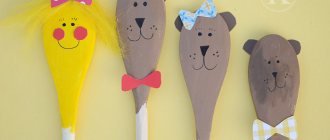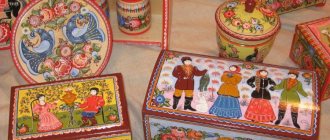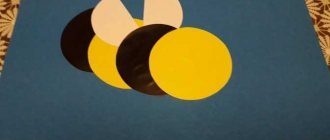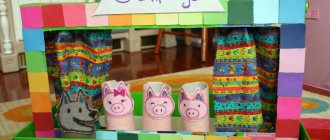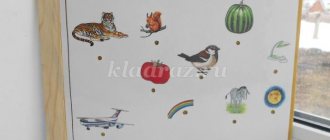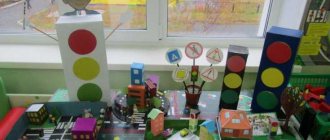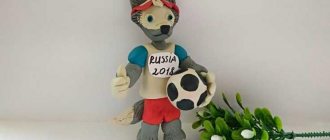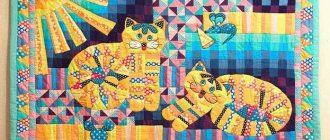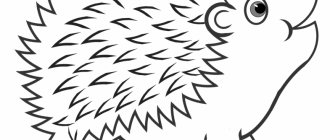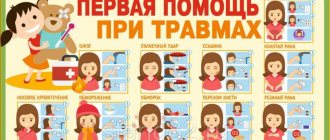First crafts
One of the most important moments in organizing the process of children's creativity is creating a situation of success. A child, especially a small one, should see and feel that everything worked out for him, that his gift really pleases his parents.
A postcard, applique or three-dimensional model will turn out beautiful if the task is appropriate for the child’s age.
It is not surprising that teachers choose crafts made from colored paper for children as their first experiments. This is a light, pliable material, easy to use and creates a festive mood with its rainbow colors.
Forming the skill of working with colored paper, as a rule, begins with applications. For the little ones, you need to prepare handouts - pre-cut details of the future picture.
Looking at the sample, children must place them correctly on the base - a piece of paper or cardboard - and then glue them in a certain order.
As a gift, a mother can be presented with a postcard with a picture of a flower: a narrow strip-stem, a circle-core, ovals or circles-petals, a pointed leaf are glued onto a sheet of cardboard folded in half; smiling sun: yellow or orange circle, ray stripes, drawn or pasted eyes and mouth; bouquet in a vase: shape of the vase, shape of flowers and leaves.
A baby can surprise his dad, uncle, brother or grandfather with an applique depicting an airplane flying in the clouds, a ship sailing on the waves, or a tank.
Creating simple three-dimensional figures of animals also turns into a fun game, which very young children who have barely learned the basics of working with glue can handle. They are based on a cylinder or cone onto which parts are glued - ears, paws, eyes, noses.
The figures turn out to be very cute and evoke sincere affection. The variety of types of applique and the ease of its production will, over time, in the process of improving skills and abilities, push children to independent creativity.
Postcard for February 23rd in the form of a suit
A greeting card is perhaps the simplest thing that is suitable for display at school, and for congratulating dad, grandfather or older brother on Defender of the Fatherland Day. Why do we propose to design it as a men's suit? Because such a card will look unusual for such a holiday, elegant and emphasize gender. We think that all men, regardless of age, will be pleased to receive (especially from a daughter or granddaughter) just such a postcard.
You choose the color of the shirt and jacket yourself, but remember that with light jackets, the shirt should be darker and vice versa. As for the tie, mothers should tell their children that its color should match both the shirt and the jacket and not be flashy, but fashionable.
For a postcard like the one in the photo, we will need:
- colored cardboard in black and red and a sheet of white office paper;
- scissors, glue stick and hot glue;
- a simple pencil;
- 6 small black buttons and a thin ribbon for tying the card.
Bend a black sheet of cardboard on both sides - these will be the sides of the jacket.
Fold a sheet of office paper in half and inside write wishes and congratulations on the holiday to the person to whom the card is intended (it is quite possible that it is a labor or physical education teacher). Glue the piece of congratulations to the “jacket” so that the message can then be easily opened and read.
We make a collar for the shirt. Cut out a rectangle with sides 15x4 cm from white paper, bend the edges of the rectangle towards its middle to form a trapezoid and glue the collar to the middle of a large sheet so that part of it protrudes beyond the edges of the sheet.
Cut out a tie from red cardstock. Its length should be approximately 20 cm. Glue the tie to the collar and glue the collar so that the folded sides cover part of the tie, forming the corners of the collar.
Next, decorate the jacket with buttons, which you glue to it using a glue gun or Moment glue. Cut it out of black cardboard and glue a pocket and a handkerchief made of red cardboard (two triangles) onto the jacket. Don't forget to fold back the top corners of the jacket sides.
All that remains is to tie the buttons with a ribbon (braid) to close the card.
Another very interesting version of a postcard with a moving airplane, which is suitable for a school exhibition, look at the video.
Templates and stencils
Having learned to confidently arrange a sheet of paper, cut it and glue it on their own, the child can move on to the next stage of mastering applied techniques - working with templates and stencils. This, at first glance, is a simple task, but in fact it requires increased attention and good coordination of movements.
Working with stencils is easier than with templates, so it’s better to start with them. It is important to introduce children to the basic rules: how to economically and conveniently arrange a stencil or template, how to hold it, how to trace an outline with a pencil.
It is better not to rush into moving to this level of difficulty. Failure can lead to disappointment, which can seriously stunt creative growth. Let the first template be a child’s palm: children like to trace their hand, tickling their fingers with a pencil, and there are a great many options for crafts consisting of such details.
Does your palm look like a maple leaf? Let's make a picture with an autumn bouquet! Does it resemble a peacock's tail? Let's glue together a proud, handsome man walking through a blooming garden! Or maybe these are hedgehog thorns?
Let's make an applique with a hedgehog bringing home a fragrant apple! Adults can suggest a direction and, together with young artists, formulate an idea for a paper craft for children, which they will be happy to implement.
Cup "Best Dad in the World"
For such a cup you will need to print out several templates - this is the template of the cup itself and the template of the box that will play the role of a pedestal.
Next, follow the step-by-step instructions.
- First, assemble the pedestal box. Cut out the template, trace it on cardboard and cut it out. You bend the sides and, after gluing them, connect them, forming a box.
- Glue a light brown rectangle onto the finished box - this is a plate for the inscription.
- Using templates (in the form of a flower or a sun) for the cup, we draw and cut out details from thick cardboard in yellow or gold colors. We bend and glue along the fold, forming cups that we glue together with the bases. It turns out to be a cup.
Making handles for the cup. Tightly wrap a thin strip (30x1.5 cm in size) of cardboard around the pencil, and then unfold it. You will get curled handles that need to be glued to the cup on both sides.- All that remains is to glue the cup to the pedestal and make the inscription “To the best dad in the world.” Various sweets or something that dad will need for work or leisure are placed in the cup: an office stationery or a set of fishing hooks.
Natural materials
You can learn to love and appreciate nature not only by observing its natural beauty, but also by using its fruits in applied creativity. This type of activity develops associative thinking and, perhaps more than other educational activities, is similar to a game.
Hand-made figures made from cones, acorns, seeds, twigs and shells awaken children's imagination and stimulate cognitive interest. A variety of techniques for working with natural materials allows you to choose the one that best suits your age, training and design.
Themed crafts for children 5 years old will help them get acquainted with the surrounding world of their native land, study the seasonal characteristics of plants, the habits of animals, and make an original and beautiful gift.
A plasticine oval with a pointed nose, studded with cones, ash parachute seeds, sunflower seeds, spruce needles or acorns, turns into a hedgehog; with a long, gracefully curved neck, complemented on the sides with a pair of leaves or large shells - like a swan; a flattened ball with an elongated head, decorated with walnut shells - like a turtle.
A tin coffee can tightly covered with plasticine, decorated with an ornament of seeds, will become a cute vase, and a tea box, covered with peas, leaves or crushed eggshells, will become a box for needlework.
Not to mention the numerous options for making people from cones and acorns, genre scenes from vegetables and fruits, panels from dried flowers and leaves.
Working with natural materials, like any creative activity, is an excellent option for interesting and rich children’s leisure time and an opportunity to create something beautiful and useful that can please friends and family. And this is also very important for children!
Safety precautions at work
When working together with your child to create a craft, you should follow certain safety precautions:
- Avoid contact with parts that are too small.
- Work with scissors and glue only under the supervision of an adult.
- Do not allow paint, glue or other liquid components to get into the child’s eyes.
We recommend reading:
- Crafts from plasticine: the best master class for children at school or kindergarten. 90 photos of the best ideas for creating plasticine figures
- Felt crafts - the best patterns and templates. Step-by-step instructions and master class for beginners (130 photo ideas)
- DIY crafts from egg trays - the best step-by-step master class, with description. TOP 100 photos of original ideas for crafts
If these simple conditions are met, the work will bring only joy and unforgettable impressions to the child.
Available materials
Acquaintance with this type of creativity usually also occurs in kindergarten. The materials used are cardboard and plastic plates, disposable cups, spoons and forks, colored bottle caps, buttons and much more.
Starting with simple crafts, children gradually move on to more complex models that require diligence, good coordination and constructive thinking. Ordinary objects used in everyday life or out of use, which have become crafts, for children - a miracle created with their own hands, a little magic!
Cereal applique
Materials you may need:
- Glue.
- Thick cardboard.
- A finished picture or photograph from which the master will work.
A wide variety of cereals are used: millet, rice, pearl barley. A circle is drawn on the cardboard, indicating the boundaries of the application. Next, coat the base areas with glue, and place the cereal of your choice on the surface.
Different details of the design are decorated with different grains. If desired, the glued cereals can be painted with ordinary watercolors.
Cotton pads
This material is popular in works with winter and New Year themes. Fluffy snow-white “rounds” seem to be asking to be used in an applique with a snowman! They easily become dense snowdrifts and light snowflakes, but can also be a sheep's coat.
Painted discs can be used in narrative pictures and panels in almost the same way as colored paper. But these works will be distinguished by volume, special warmth and softness.
Making a Floral Card
Before starting work, you should prepare a sheet of thick cardboard, colored paper, glue and scissors. Next you need to follow the step-by-step instructions:
- Choose a template for any flower you like: tulip, original rose, lush peony.
- Using the template, outline the main details: bud, leaves and stem.
- Fold a sheet of cardboard in half to make a simple postcard model.
- Paint the outside of the card with watercolors and let the paint dry.
- Glue the flower details onto the title page.
If the child wishes, you can decorate the card with additional icons or symbols, beads or rhinestones. Parents can help make a congratulatory inscription.
Pasta
Thanks to the variety of sizes, shapes and even colors, this food product has long established itself as a material for creativity. And not only for children! Not every traditional material can boast such a variety of forms of use - from simple and complex paintings to decorative dishes.
It is better for younger children to master the technology of flat paintings, where pasta can act as sun rays, flowers or flower petals, elements of folk ornament. Later, you can get acquainted with semi-volumetric panels, and then move on to making three-dimensional models.
A rustic house assembled from pasta tubes, flower bouquets from pasta shells or spirals, cups, teapots, candlesticks or boxes are excellent DIY craft options for children 9 years old and older.
pros
When a teacher asks to bring a craft, first of all this is done for the child and his parents. Because this time together has a positive effect on both. The following happens:
- Bringing together and uniting parent and baby;
- The emergence of an atmosphere of fun and carefree;
- Development of non-standard thinking;
- Development of hand motor skills;
- Ability to get things done;
- Development of creative skills.
Children's crafts done together with their parents will be remembered for a long time and will be imprinted with warm moments in the memory.
Plastic bottles
Once you are carried away by this type of creativity, you can not only surprise your friends with your wild imagination, but also, in the meantime, decorate a summer cottage for the delight of your beloved grandmother! So, a squad of cheerful gnomes can line up along the garden path, and one plastic bottle of any size is enough to make each of them.
It is enough to cut off the bottom and paint with paints, drawing a suit, hat, hair, beard, eyes, nose and mouth. Of course, creating complex models requires the participation of adults, since it involves the use of sharp knives, such as stationery knives.
But most of the work - cutting, coloring, assembling - the child can do on his own.
Before you begin this work, you should carefully consider the procedure, prepare all the necessary materials and follow the step-by-step instructions for making crafts for children, invented independently or taken from other sources.
Plastic construction, in a sense, is akin to Lego: it combines three-dimensional parts made from source materials of suitable shape (bottles of different sizes and shapes).
So you can make the heroes of your favorite cartoons - Winnie the Pooh, Minions, Stitch or Pony, characters from folk tales - the Old Man, the Old Woman, the Fox, the Wolf and the Hare, and make themed compositions. And during the summer holidays, the dacha will turn into a Magic Land!
How to sculpt figures
Any snow except artificial snow is suitable for work. If the snow is too crumbly and does not clump, it must be specially moistened. There are several options on how to do this:
- collect snow in containers and bring them indoors for a couple of hours;
- take out the hose and spray the space in which the snow sculpture will be collected;
- add a little warm water to containers where loose snow has already been collected.
You need to take into account that you will need a lot of snow. Buckets or large basins may not be enough to make a large snow figure, so the option with a hose is better in this case.
Additionally, you need to prepare shovels for collecting snow - it will be difficult to roll away wet, melted clods, and this will have to be done quickly. If the snow is dry, then the temperature is noticeably below zero and there is little time before it turns into ice shards.
Chick
When preparing to sculpt snow figures from snow with your own hands, you need to imagine the shape and dimensions of the structure in advance.
You can not only draw an object or print a photograph of someone else’s work, but also sculpt a model from plasticine.
A workpiece with marked dimensions will help distribute tasks between participants in the work, otherwise the parts may not fit together.
Samovar
In general, you can make figures from snow in two ways - from snowballs rolled up according to the principle of a classic snowman, and from material pressed into shape.
In the first case, the snow will be compacted naturally due to the weight of the snowball itself.
The second option requires compacting the material in a container or pre-created box. Such a frame the size of the future figure can be made from old plywood. This is the method used to make huge snow figures for city Christmas trees.
If the scale of the construction is not so significant, you can limit yourself to ready-made containers - buckets, tanks, cut plastic bottles and canisters.
Tools
Life-size figures depicting people are most often made from snow globes. To get a high-quality work, the balls are simply placed on top of each other according to the snow woman principle.
The gaps between the forms are covered with wet snow and compacted tightly. The final shape in accordance with the picture can be given already at this stage - adding volume to the hem of the Snow Maiden, widening the shoulders for the figure of a fairy-tale hero. After freezing, all that remains is to work out the small details with a sharp tool and paint the creation.
Additionally for work you will need:
- shovels and large knives if small details and detailing are planned;
- plastic bags for forming small parts;
- paint - alcohol ink or gouache diluted in water;
- large brushes or washcloths made of tow for painting.
Dense compacted snow filled with water is similar in strength to cement or plaster. Ice, if you plan to use this transparent material in the figures, is even stronger.
To cut complex structures, you can use a chainsaw if one of the fathers has the opportunity to use such a tool. We must not forget about replacement mittens for the whole company and hot tea - even the simplest snow figures for kindergarten will take several hours.
Fish
Salty dough
An amazing material that successfully competes with plasticine, natural and polymer clay and other plastic masses. Its beauty for children's crafts also lies in the fact that the finished product can be colored at your discretion, using an unlimited number of shades.
The dough itself is prepared from flour, salt and water, taken, for example, in the amount of 300 g X 300 g. X 200 ml respectively. Completely dissolve fine salt in cold water, and then gradually add flour to it, stirring as long as possible. Knead the mixture on the table until smooth.
The required softness, density, viscosity and stickiness are achieved by adding little by little (if necessary) water or flour. The finished dough is wrapped in film and kept in the refrigerator for about 3 hours. Although not edible, the eco-friendly, hypoallergenic material is ready for use!
Kids will be happy to knead it, roll it out and twist it, smear the parts one on top of the other, cut them into a stack, creating the effect of fur or grass. This is an excellent option for making crafts for Children's Day - individual or collective - in which you can make children's dreams, fantasies and desires come true
Whether it be games with friends and fairy-tale characters, flying on an airplane or firebird, traveling to distant lands or meeting aliens - salt dough will make the work expressive and bright, and the process of creating it enjoyable.
Speaking about the development of creative abilities, a few words should be said about the role of adults in the development of a little master. After all, the best incentive to encourage a child to learn and create is a keen interest in his activities on the part of his parents. In joint creativity, spiritual intimacy is born. Studying technologies and techniques together allows you to get to know each other better.
Repeat at home what your child learned in kindergarten or at school, get acquainted with interesting new products offered by teachers and craftsmen, look at photos of crafts for children, and figure out together how you can make the one you like. And please each other and your loved ones with masterpieces made by yourself.
MAGAZINE Preschooler.RF
Master class for parents and children on the topic “My new friend”Municipal budgetary preschool educational institution “General developmental kindergarten No. 24 “Rainbow” with priority implementation of the artistic and aesthetic direction of development of pupils” in Nevinnomyssk.
Prepared and conducted by: Teacher of MBDOU No. 24 of Nevinnomyssk N.Yu. Minakova
Topic: “My new friend” .
Objectives: inform parents about children's friendship, show how to make a toy for a puppet show. Show a mini theatrical performance together. Create a desire to spend time with children with great pleasure.
Material: multi-colored socks, buttons, ribbons, threads, cardboard blanks, decorative elements. Scissors, needles, paste, brushes.
Progress of the master class:
-Good evening, parents. Today I would like to talk to you about your children’s friends. After all, friendship is one of the most important components of any person’s life. The first friend appears in childhood; often he becomes a lifelong friend. In any case, childhood friends are a special item on the list of our friends and acquaintances. For some reason, we look forward to meeting them with special trepidation, because only they can, even if only for a moment, take us back to childhood. And there was so much there: first successes and disappointments, tricks, sympathy, etc. And every parent, without a doubt, wants his child to have many good friends. Today I’ll tell you about how useful children’s friendship is, how to help your child find a friend and how to support him in his first friendships.
-Children's friendship is the first step of a little person towards socialization. For the first time, someone other than your parents evaluates your actions and plays with you. It has been scientifically proven that children deprived of friends in childhood experience serious difficulties in establishing contacts and connections in adulthood.
-Why is children's friendship so important?
-This is an opportunity to learn to communicate, respect and appreciate another person. The number of friends will depend on several factors:
- example of parents
-features of the child’s psychological make-up.
-If parents do not have real friends, if it is not customary for the family to receive guests, then the child will most likely adopt the parent’s model of behavior.
Much, of course, depends on the child’s personal characteristics. If he is an extrovert, then having many friends is vital for him. Introverts are more closed; one or two friends are usually enough for them.
Children begin to be drawn to their own kind already at 2-3 years old. This manifests itself in joint games in the sandbox or on the playground. At this age, children mostly play on their own, actively fight for toys and try in every possible way to express their “I” . At the age of 4-5 years, games become more conscious, common interests and friendly affection appear.
-But friendship does not appear out of nowhere; a child must be taught to be friends. To do this, it is necessary to ensure constant contact with other children: regular visits to the playground, clubs and sections for preschool children, and kindergarten. The child watches how the mother communicates with other mothers and tries in every possible way to imitate. You should not protect your child from communicating with peers just because he may be offended or not accepted into the company. Better help him find his social circle.
Some children find it very difficult to make friends, but this does not mean that their childhood should pass without friends. Here are some tips on how to help them.
Very shy children. Such children need special parental attention. Emphasize its importance in every possible way, do not scold him for shyness and teach him how to behave in certain situations.
Annoying children. Typically, such children demand maximum attention from their peers, which often scares them away. The main reason for this behavior is low self-esteem and lack of self-confidence. It is important to constantly emphasize that you value your child for who he is.
Uncooperative children. They constantly quarrel, and with all their friends at the same time. Parents should carefully understand each quarrel and identify the reason for such strange behavior.
Greedy children. Often parents force their child to share the most valuable things, in fear that others will suspect their child of greed. Children, like adults, perceive what belongs to them as part of themselves. Why don't you, for example, share your iPhone or give a friend your laptop? If it is customary in a family to treat each other with goodies and give each other gifts, then children, as a rule, do not have any problems with greed.
-To make it easy for a child to take the first step towards a peer, you can teach him to get acquainted using the example of a game where a favorite teddy bear acts as a friend, for example.
-Today I will show you how to make a new friend for you and your child. As you work, your child will already love it, I’m sure of it. And then you will teach them to be friends. Do you agree? Then get to work.
-In front of you is a box with multi-colored socks. Together with your child, choose one sock. Don't forget to listen to your children's opinions.
Turn the sock inside out, glue the cardboard blank to the inside out and to the sock, having coated it with glue in advance. Let's let it dry a little.
Then turn it right side out. Our friend's face is ready. All that remains is to sew on the eyes, nose, and hairstyle.
Approach the decor box and select the details you need.
So quickly and without much expense, our new friend is ready.
Now you need to help your child choose his name and start making new friends.
And I suggest that parents think about and show their children a theatrical mini-story on the theme “Friendship” .
Watch parents improvise. And then the dialogue between the children.
-Thank you very much, parents, for coming to us today and participating in the master class. I hope you were satisfied and can now help your child find true friends. And of course you realized that with the help of a new friend you can always be aware of all the events that happen in the life of your child.
| Next > |
